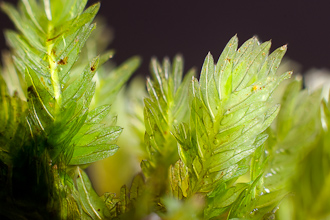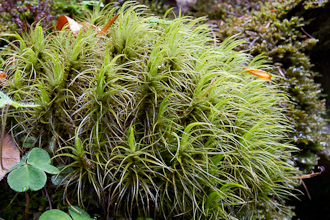
-
Plant growth habit
-
Shoot growth form / colour
-
Details of the leaves
- Hairpoint:
-
Leaves recurved, hooked, squarrose
Note:
Apices bent abruptly to the side or downwards - Costa:
- Teeth:
- Leaf margins:
- Leaf surface:
-
Reproductive structures
- Distinctive gemmae present:
- Colour of seta:
- Form of the capsule:
Note:
Distinctive capsules only.
When I first attempted to meet the challenge of moss and liverwort species identification, I tried to apply similar methods to those I use in identifying unfamiliar flowering plants, that is to learn the characters of the higher-level taxa to which each species belongs.
Familiarity with flowering plant families is a good start to homing in on potential candidate species, and I assumed the same would be true of bryophytes and their higher-level taxa. I was informed by expert bryologists that this approach would not work for bryophytes, and that I'd just have to learn the species one by one.
Experience has shown me that the experts were right, indeed the British Bryological Society Field Guide doesn't mention families at all. The text does note the order to which each described species belongs, but that doesn't narrow the options down very much. In contrast, it's hard to envisage a credible flowering plant field guide that didn't name the families for all species covered.
The key reason for this difference is, I think, that for the most part the characters being used to identify bryophytes are details of the gametophyte which are, of course, exclusively vegetative features. And as with flowering plants, the vegetative organs tend to assume morphologies dependent more on habitat than on taxonomic position. Attempting to identify flowering plants by vegetative characters alone would present similar difficulties to that encountered in determining bryophyte species.
- Atrichum undulatum
- Barbula sardoa
- Barbula unguiculata
- Bryum capillare
- Bryum pallens
- Dichodontium palustre
- Funaria hygrometrica
- Gymnostomum aeruginosum
- Gyroweisia tenuis
- Hedwigia stellata
- Mnium hornum
- Orthotrichum cupulatum
- Orthotrichum diaphanum
- Orthotrichum stramineum
- Pogonatum aloides
- Pohlia melanodon
- Polytrichum commune
- Polytrichum piliferum
- Pseudocrossidium revolutum
- Racomitrium fasciculare
- Racomitrium heterostichum
 Dichodontium palustre (Dicranaceae)
Dichodontium palustre (Dicranaceae)- Rhizomnium punctatum
- Schistidium rivulare
- Syntrichia laevipila
- Syntrichia ruralis ssp. ruraliformis
- Tetraplodon mnioides
- Tortula muralis
- Trichostomum brachydontium
- Ulota bruchii
- Ulota phyllantha
Many erect mosses show this leaf arrangement, but it is to be found in some prostrate species too. Presumably it's more a function of inherent growth patterns arising from how the apical cell divides, rather than a particular adaptation to the environment.
- Fissidens bryoides
- Fissidens dubius
- Fissidens taxifolius
Mosses show the three fundamental leaf arrangements: spirally inserted, arising on two opposite sides of the shoot (distichous) and arising from one side only (secund). In each case, there's presumably selection pressure tending to reduce one leaf shading another, but which arrangement is most efficient?
- Dicranum majus
- Palustriella commutata
Having most leaves oriented to one side of the plant is not necessarily inefficient in terms of utilisation of available space, as leaves on one shoot will not be shaded by the adjacent shoot. Of course, this assumes that the shoots are clumped together and share the same leaf orientation, but these features do seem frequent in secund moss species.
- Aulacomnium androgynum
- Bryum pseudotriquetrum
- Eurhynchium striatum
- Plagiomnium ellipticum
- Plagiomnium undulatum
- Rhizomnium rostratum
Mosses with widely-spaced leaves often also have large leaves, presumably as the latter would shade one another if more closely packed. And large leaves seem most frequent in species that occupy damp and wet habitats, the luxuriant development no doubt reflecting the availability of abundant moisture.






